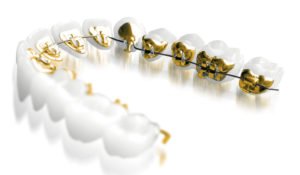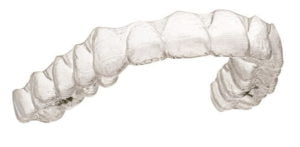FAQs about invisible braces

There’s not a lot that we don’t know about ‘invisible’ orthodontics and we’re pleased to offer some of the most inconspicuous braces around. Over the years we’ve seen thousands of patients for orthodontic consultations and answered hundreds of questions about ‘invisible’ braces.
We’re always keen to share our knowledge, so if you’re thinking about straightening your teeth discreetly you may be interested in the answers to some of our most frequently asked questions.
Are invisible braces actually invisible?
Unfortunately no, ‘invisible braces’ is a term that’s been adopted to describe a range of very inconspicuous braces. No brace could ever be truly invisible – but there are some that come close. Invisalign, for example, uses virtually invisible clear aligners to move teeth, while lingual braces (below) are completely concealed behind your teeth. Clear and tooth-coloured fixed braces are more visible but still much more discreet than metal braces.

Are they as good at straightening teeth as traditional braces?
Clear fixed braces work in the same way as traditional metal braces, so they’re very good at straightening teeth. Clear aligners like Invisalign are less effective at treating certain problems, for example impacted teeth, but for the right cases they can achieve excellent results.
Are invisible braces removable?
There are some types of ‘invisible’ braces that can be removed, but only for eating, drinking and to brush your teeth – if you take them out for too long your treatment could be affected. We offer a number of different removable options including Invisalign (below), Simpli5 and the Inman Aligner.

Are they more expensive?
The cost of braces varies from patient-to-patient, and for mild cases an ‘invisible’ option such as Six Month Smiles can be more cost effective than visible alternatives such as Damon braces. Lingual braces tend to cost more than traditional braces or aligners because they usually have higher lab fees; require specialist equipment; and appointments to adjust your brace can take slightly longer.
Can I have invisible braces on the NHS?
NHS funding for orthodontic treatment is only available to those who require treatment to improve their dental health and most dental and orthodontic clinics will only have a contract to treat under 18s. Because NHS funding is limited usually only metal fixed braces are available. At Sensu, we don’t have an NHS contract and all of our dental and orthodontic treatments are only available on a private basis. This means there’s no NHS waiting list and you can choose from a range of braces.
Will my invisible brace turn yellow?
Clear, fixed braces feature clear or tooth-coloured brackets that cleverly blend in with your teeth. The brackets themselves have been designed to be stain resistant, however, sometimes elastic bands are used to attach your brace’s arch wire to your brackets – and these can be more vulnerable to stains.
You can limit your risk of stains by avoiding very colourful foods like curries, berries, mustard and ketchup; brushing regularly; and steering clear of cigarettes. If you are unlucky enough to stain your elastic bands, don’t worry, we can change them at your next appointment. Clear self-ligating braces don’t require elastic bands, so they’re a good choice if you’re worried about stains, while Invisalign aligners are changed every two weeks, so they shouldn’t have a chance to discolour.
Will my teeth stay straight after invisible braces?
The results of orthodontic treatment can be maintained using fixed and/or removable retainers, and ‘invisible’ braces are no exception. Keeping your teeth straight is just as important as your initial treatment and you’ll need to wear retainers indefinitely to ensure that your teeth don’t move. Fortunately retainers are very unobtrusive and they’ll quickly become part of your routine.



